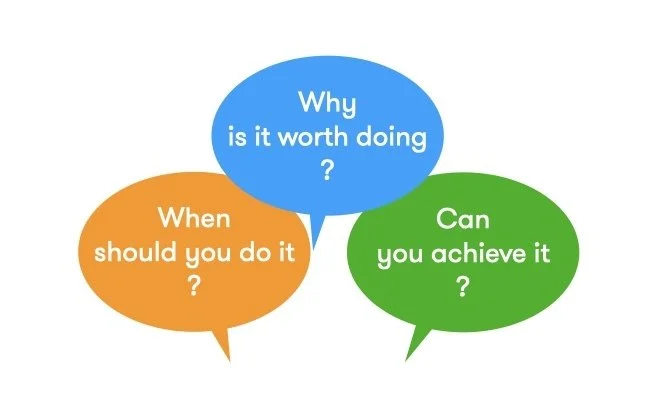Prioritisation in 3 ‘simple’ questions
There are so many frameworks, tools and techniques for prioritising out there, that it’s tricky to know which one to pick (I see the irony here). As far as I’m concerned, whatever you are prioritising, whether it’s what feature to build for a product, what project to undertake, or what you should study, it all comes down to answering these three simple questions:
Why Is it worth doing?
When should you do it?
Can you achieve it?
1. Why is it worth doing?
It all starts with value. If you don’t define value up front, you cannot designate one thing as being more valuable than another. You won’t be prioritising, you’ll just be individually selecting something to do next. To make sure something is worth doing, consider:
Does it align with your vision and objectives?
Does it move you closer towards achieving those objectives?
Is it viable? Does it contribute to long term growth? Is it sustainable?
Is it desirable? Does it meet specific needs?
Do people actually want this? Do you actually want this ?!
Does it solve a problem or realise an opportunity?
What is the smallest slice that will achieve value?
2. When should you do it?
The next question is one of timing. You might have decided you need to do it, but do you need to do it now, or is it better to wait? Can you complete it in time? Can you (and you should always try to) slice it down into something smaller that can be delivered sooner? How urgent is it and what is the impact of time on the outcomes you hope to achieve?
Use the Cost of delay to get an understanding of the expected value in relation to time, by combining urgency with value. Consider the following for a given timeframe (e.g. a week, a month, 3 months):
What would it cost you if you delayed?
What would it be worth to you if you delivered early?
Don’t get fixated by just the cost though. These timing considerations also apply to things such as date driven legislation, regulatory compliance, reputation, or how the value of your objectives may decay over time.
3. Can you achieve it?
It’s one thing to want to achieve something, it’s quite another to be able to achieve it. Push yourself, but be realistic. Is it feasible for you to undertake and complete this, does it play to your strengths, and once it’s done are you in a position to support it? Time, energy and (usually) money are limited, so to prioritise what you want to do, you also need to be decisive on what not to do.
The key things you need to consider are:
Do you have the capability? Do you need to partner with someone else?
Do you have the capacity? Do you need to stop something you are already doing?
What is the smallest slice that you can deliver sooner that will achieve value?
Do you have the capability and capacity to support it once it’s done?
Next question
Three simple questions to make sure you take the time to intentionally prioritise rather than individually assess and select.
The final question is, will you ask them?

